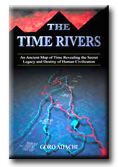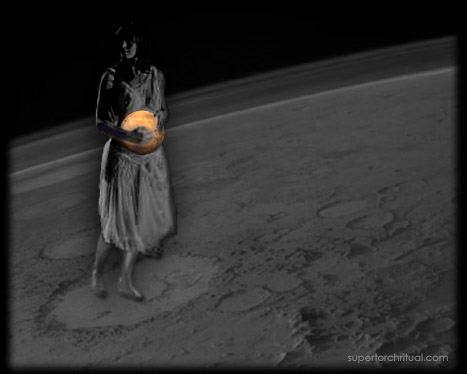|
|

Welcome | Time Rivers | Book | The Nile Decoded | Etemenanki
Welcome to the Realm of
the Time Rivers
By Goro Adachi

What Is the ‘Time River Theory’?
It’s about the discovery of an astounding system of literal ‘rivers of time’, which may even be described as the ‘fingerprints of the gods’. It is a planetary ‘Rosetta Stone’ for decoding history or even ‘reality’ itself. Sounds overly grandiose? Yes, but it’s not necessarily an exaggeration given the nature of the discovery.
Proving the existence of the ‘Time Rivers’ has explosive implications. And the claim here is that this has indeed been done. But that’s just the beginning of the story. What the ‘Time Rivers’ tell us - about who we are and everything else - is equally, if not more, profound.
The Time River Theory (TRT) is ultimately about the discovery and decoding of the ‘blueprint’ of reality - a blueprint that was literally carved on this planet by an unknown high intelligence. This is a brand new field just activated in 2003 via the publication of The Time Rivers. It’s about time we opened up the Gateway... to a new dimension.
To get a little more specific, here is an abbreviated list of what the Time River Theory is about and what it reveals (at least in the book The Time Rivers):
 A grand system of literal ‘rivers of time’ flowing on our planet, created by some mysterious, higher intelligence. A grand system of literal ‘rivers of time’ flowing on our planet, created by some mysterious, higher intelligence.- The intricate ‘Time River scheme’ produced by the Nile, Tigris-Euphrates, Mississippi, etc. showing us the entire timeline of human civilization, both past and future.
- Solutions to deep ancient mysteries of Egypt, Sumer, and even Mars.
- Encoded ‘messages’ revealing extraterrestrial and/or extra-temporal origins of human civilization.
- The 21st century being specifically pinpointed as the edge of time, when a ‘timegate’ opens up to bring mankind back to the realm of ‘Genesis’.
- Tangible and unique solutions to the biblical events of Genesis such as Creation, the fallen angels, the Great Flood, the Ark, etc.
- An encoded timeline of the United States anticipating ‘9/11’, an event suggested to mark the ‘end’ of the United States.
Please note that the the theory is extensive and still rapidly evolving, thus the above should be viewed as only the tip of the iceberg.
To learn more about the TRT, please see The Nile Decode - a paper posted online revealing the basic components of the thesis.
Current Status
A lot of very positive feedback has been received from those who have read The Time Rivers and/or The Nile Decoded. Some samples are posted here.
What about the reaction of the 'alternative history' crowd? How are they responding to the 'quantum leap' that the TRT would represent to their field? The answer to this question is not yet clear since the theory was revealed only recently and is not yet widely known. But the anticipation here is that the reaction would be more or less mixed. Because the Time River Theory is something that radically shifts the whole paradigm, there will probably be those in the field who are perhaps just too 'old' (at least mentally) to keep up with the sudden and rapid movement forward. And this is fine; the Time River system is a discovery for a new generation of truth seekers who maintain a fresh mind capable of clear and creative thinking.
There is actually so much more to the Time River scheme than made available so far (including the book), which is undoubtedly contributing to the tone of confidence expressed here. Hopefully there are many of you who can intuitively sense this 'energy' lurking just beneath the surface... It's all getting ready to come out now. If not already, please study the available material, understand the implications, and... well, join the revolution!
Available Material:
|
|
|
|
|
Madeleine de France, Queen of Scotland, 1536
(Madeleine de France (1520-37) Queen of Scotland, 1536 )
|
https://www.meisterdrucke.us/fine-art-prints/Corneille-de-Lyon/80721/Madeleine-de-France,-Queen-of-Scotland,-1536.html
|
|
|
|
|
Madeleine of Valois
Madeleine of Valois (10 August 1520 – 7 July 1537) was a French princess who briefly became Queen of Scotland in 1537 as the first wife of King James V. The marriage was arranged in accordance with the Treaty of Rouen, and they were married at Notre-Dame de Paris in January 1537, despite French reservations over her failing health. Madeleine died in July 1537, only six months after the wedding and less than two months after arriving in Scotland, resulting in her nickname, the "Summer Queen".
 Madeleine (back right) with her mother and sisters, from the Book of Hours of Catherine de'Medici.
Madeleine was born at the Chteau de Saint-Germain-en-Laye, France, the fifth child and third daughter of King Francis I of France and Claude, Duchess of Brittany, herself the eldest daughter of King Louis XII of France and Anne, Duchess of Brittany.
She was frail from birth, and grew up in the warm and temperate Loire Valley region of France, rather than at Paris, as her father feared that the cold would destroy her delicate health. Together with her sister, Margaret, she was raised by her aunt, Marguerite de Navarre until her father remarried and his new wife, Eleanor of Austria, took them into her own household.[1] By her sixteenth birthday, she had contracted tuberculosis.[2]
Marriage negotiations
[edit]
Three years before Madeleine's birth, the Franco-Scottish Treaty of Rouen was made to bolster the Auld Alliance after Scotland's defeat at the Battle of Flodden. A marriage between a French princess and the Scottish King was one of its provisions.[3] In April 1530, John Stewart, Duke of Albany, was appointed commissioner to finalize the royal marriage between James V and Madeleine.[4] However, as Madeleine did not enjoy good health, another French bride, Mary of Bourbon, was proposed.[5]
James V sent his herald James Atkinhead to see Mary of Bourbon,[6] and a contract was made for James to marry her. King James travelled to France in 1536 to meet Mary of Bourbon, but smitten with the delicate Madeleine, he asked Francis I for her hand in marriage. Fearing the harsh climate of Scotland would prove fatal to his daughter's already failing health, Francis I initially refused to permit the marriage.[7]
James V met Francis I and the French royal household between Roanne and Lyon on 13 October.[8] He continued to press Francis I for Madeleine's hand, and despite his reservations and nagging fears, Francis I reluctantly granted permission to the marriage only after Madeleine made her interest in marrying James very obvious. The court moved down the Loire Valley to Amboise, and to the Chteau de Blois, and the marriage contract was signed on 26 November 1536.[9]
Wedding at Notre-Dame
[edit]
 Notre-Dame de Paris Notre-Dame de Paris and its environs, known as the Parvis, Jean Marot, 17th century
In preparation for the wedding, Francis I bought clothes and furnishings for Madeleine; jewels and gold chains were supplied by Regnault Danet, linen and cloths by Marie de Genevoise and Phillipe Savelon, clothes by the tailors Marceau Goursault and Charles Lacquait, veils by Jean Guesdon, and trimmings by Victor de Laval, who also made passementerie for a bed that Francis gave the couple. The goldsmith Thibault Hotman made silver plate for Madeleine.[10][11] The merchants of the royal "argenterie", René Tardif and Robert Fichepain supplied silks and woollen cloth.[12] A quantity of gold and silver trimmings for embroidering the clothes of Madeleine and her ladies were ordered from Baptiste Dalverge, a wire-drawer.[13] A platform walkway was constructed from the Bishop's Palace to Notre-Dame de Paris.[14]
After a Royal Entry into Paris on 31 December 1536,[15] they were married at Notre-Dame on 1 January 1537.[2] There was a banquet that night in the Great Hall of the Palais de la Cité.[16] Over the next two weeks there were further celebrations and tournaments at the Chteau de la Tournelle and Louvre.[17] The wedding festivities in 1537 were similar to those of 24 April 1558, for the wedding of Mary, Queen of Scots, and Francis, Dauphin of France.[18]
Francis I provided Madeleine with a generous dowry of 100,000 écu, and a further 30,000 francs settled on James V. According to the marriage contract made at Blois, Madeleine renounced her and any of her heirs' claims to the French throne. If James died first, Madeleine would retain for her lifetime assets including the Earldoms of Fife, Strathearn, Ross, and Orkney with Falkland Palace, Stirling Castle, and Dingwall Castle, with the Lordship of Galloway and Threave Castle.[19]
 Coat of arms of Madeleine of Valois as Queen consort of Scots
In February the couple moved to Chantilly, to Senlis and Compiègne, where James received the Papal gift of hat and sword.[20][21][22] They stayed two nights at the Chteau de La Roche-Guyon.[23] After months of festivities and celebrations, the couple left France for Scotland from Le Havre in May 1537. The French ships were commanded by Jacques de Fountaines, Sieur de Mormoulins.[24] On 15 May, English sailors sold fish to the Scottish and French fleet off Bamburgh Head.[25] Madeleine's health deteriorated even further, and she was very sick when the royal pair landed in Scotland. They arrived at Leith at 10 o'clock on Whitsun-eve, 19 May 1537.[26]
According to John Lesley the ships were laden with her possessions;
"besides the Quenes Hienes furnitour, hinginis, and appareill, quhilk wes schippit at Newheavin and careit in Scotland, was also in hir awin cumpanye, transportit with hir majestie in Scotland, mony costlye jewells and goldin wark, precious stanis, orient pearle, maist excellent of any sort that was in Europe, and mony coistly abilyeaments for hir body, with mekill silver wark of coistlye cupbordis, cowpis, & plaite."[27]
A list or inventory of wedding presents from Francis I also survives, including Arras tapestry, cloths of estate, rich beds, two cupboards of silver gilt plate, table carpets, and Persian carpets.[28][29] Francis I also gave James V three of the ships, the Salamander, Morsicher, and Great Unicorn.[30] Madeleine took up residence at Holyrood Palace on 21 May 1537.[31]
French household in Scotland
[edit]
The French courtiers who came with her to Scotland to form her household included; her former governess, Anne de Boissy Gouffier, Madame de Montreuil; Anne de Viergnon, Madame de Bren or Bron; Anne Le Maye; Marguerite de Vergondois her chamberer; Marion Truffaut, her nurse; her secretary, Jean de Langeac, Bishop of Limoges; master household, Jean de St Aubin; squires and cupbearers Charles de Marconnay and Charles du Merlier; the physician Master Partix; pages John Crammy and Pierre de Ronsard; furrier Gillan; butcher John Kenneth; barber Anthony.[32][33][34] A physician from Paris, Jacques Lecoq, set out later to join her in Scotland.[35]
Madeleine wrote to her father from Edinburgh on 8 June 1537 saying that she was better and her symptoms had diminished. James V had written to Francis I asking him to send the physician Master Francisco, and Madeleine wrote that he was now needed only to perfect her cure. She signed this letter "Magdalene de France".[36] However, a month later, on 7 July 1537, (a month before her 17th birthday), Madeleine, the so-called "Summer Queen" of Scots, died in her husband's arms at Holyrood Palace.[37]
James V wrote to Francis I informing him of his daughter's death.[38] He called Madeleine "my dear companion" – votre fille, ma trés chére compaigne.[39]
Queen Madeleine was interred in Holyrood Abbey in Edinburgh, next to King James II of Scotland. Black mourning clothes were worn at her funeral, and an order was sent to the merchants of Dundee to provide black cloth. Her household servants were provided with "dule gowns", and horses at the procession had black cloths and trappings.[40][41] The chapel at Holyrood Palace was draped with cloth from Milan.[42] The grave was desecrated by a mob in 1776 and her allegedly still beautiful head was stolen.[43]
One of her gentlewomen, Madame de Montrueil or Motrell, visited London on her way back to France. She said that Madeleine "had no good days after her arrival there (in Scotland), but always sickly with a catarrh which descended into her stomach, which was the cause of her death".[44]
An inventory made of the king's goods in 1542 includes some of her clothes, furnishings for her chapel, six stools for her gentlewomen to sit upon, and gold cups and other items made for her when she was a child.[45]
Madeleine's marriage and death were commemorated by the poet David Lyndsay's Deploration of Deith of Quene Magdalene; the poem describes the pageantry of the marriage in France and Scotland:
O Paris! Of all citeis principall!
Quhilk did resave our prince with laud and glorie,
Solempnitlie, throw arkis triumphall. [arkis = arches]
* * * * * *
Thou mycht have sene the preparatioun
Maid be the Thre Estaitis of Scotland
In everilk ciete, castell, toure, and town
* * * * * *
Thow saw makand rycht costlie scaffalding
Depaynted weill with gold and asure fyne
* * * * * *
Disagysit folkis, lyke creaturis devyne,
On ilk scaffold to play ane syndrie storie
Bot all in greiting turnit thow that glorie. [greiting = crying: thow = death][46]
Epitaphs in Latin were composed by the French writers Etienne Dolet, Nicolas Desfrenes, Jean Visagier, and an anonymous poet. Gilles Corrozet and Pierre de Ronsard wrote verses in French.[47]
Less than a year after her death, following negotiations completed by David Beaton, James V married the widowed Mary of Guise. She had attended his wedding to Madeleine, and perhaps her uncle, Jean, Cardinal of Lorraine, suggested her to Francis I as a bride for the Scottish king.[48] Twenty years later, listed amongst the treasures in Edinburgh Castle were two little gold cups, an agate basin, a jasper vase, and crystal jug given to Madeleine when she was a child in France.[49]
|
|
|
|
|
Visual y simbólicamente impactante, no tuve problemas para discernir una alusión codificada a los viajes en el tiempo , sobre la cual pueden leer todo en mi artículo " Relatividad en el Hudson ". La principal pista inicial que me dio pie fueron las asombrosas imágenes del choque acuático y el escape, que eran casi idénticas a la escena del impacto de la nave espacial en la secuencia inicial de El Planeta de los Simios .
 
Eso me llevó a pensar en el efecto de "dilatación temporal" de la Teoría de la Relatividad Especial de Einstein (cuanto más rápido se viaja, más lento fluye el tiempo en relación con los observadores más lentos), que es literalmente "viaje en el tiempo" y el medio por el cual los astronautas de El Planeta de los Simios viajan al futuro. Lo que descubrí mediante un cálculo simple fue que el problemático viaje final del Vuelo 1549 se originó en "octubre de 1307", precisamente cuando los Caballeros Templarios, como organización pública y legal, llegaron a un abrupto final cuando el rey Felipe IV de Francia y el papa Clemente V atacaron duramente a la Orden, desmantelando rápidamente a los banqueros-guerreros a quienes el rey debía una fortuna.

Los Templarios eran marineros altamente hábiles que contaban con su propia flota de barcos (que algunos miembros probablemente utilizaban para evadir las fuerzas del rey). Por ello, se ha especulado ampliamente que los Caballeros Templarios ya habían visitado y explorado América mucho antes de Colón (quien tenía vínculos familiares con la Orden). Estados Unidos, como algunos han argumentado, podría incluso considerarse una nación templaria construida sobre, y aún impulsada por, principios templarios —incluyendo ideas gnósticas y el culto a la diosa/Isis /Sofía (=> Estatua de la Libertad)—, que son en gran medida intercambiables con los principios masónicos (ya que la Orden probablemente se fusionó con una rama de la masonería en Escocia a través de la familia Sinclair tras el arresto masivo). Es bien sabido, por ejemplo, que muchos de los miembros fundadores y presidentes de Estados Unidos eran masones, incluyendo a Harry Truman, masón de grado 33, quien ordenó el lanzamiento de dos bombas atómicas sobre Japón durante la Segunda Guerra Mundial. Fue la aterradora culminación del Proyecto Manhattan , iniciado después de que físicos prominentes, entre ellos Albert Einstein, advirtieran al presidente Roosevelt sobre el advenimiento de armas basadas en fisión nuclear.
La reacción nuclear es una manifestación dramática de la famosa ecuación de "equivalencia masa-energía" de Einstein, E = mc₂ , derivada de la Relatividad Especial . (La "c" en la ecuación representa la velocidad de la luz en el vacío). La materia se convierte en energía. Es precisamente por esta razón que el primer portaaviones de propulsión nuclear del mundo, en ocasiones especiales, luce con orgullo la ecuación en su cubierta, como este año, celebrando su 50.º aniversario (véase la imagen inferior) . El barco se llama... USS Enterprise .
 [ Enterprise se encuentra actualmente en su fase final de implementación y [ Enterprise se encuentra actualmente en su fase final de implementación y
será dado de baja en marzo de 2013]
Hay otra "USS Enterprise"... una nave espacial muy querida en Star Trek , de la cual se bautizó el transbordador espacial Enterprise (originalmente se llamaría "Constitution"). Justo a tiempo, y en perfecta sintonía con el patrón subyacente, Star Trek y la nave espacial Enterprise se convirtieron en un tema candente en mayo de 2012...

11 de mayo Un ingeniero cree que una verdadera nave espacial Enterprise
es posible en 20 años
18 de mayo ¿Podría realmente volar una USS Enterprise del siglo XXI?
...incluida una historia que involucra directamente a SpaceX Dragon , que transportaba a bordo las cenizas de "Scotty" (el actor), quien fue ingeniero jefe del Enterprise en la serie original de Star Trek.

El 22 de mayo, "Scotty" de Star Trek finalmente fue lanzado al espacio.
" Enterprise " fue también el título de la última serie de televisión de Star Trek, que se emitió entre septiembre de 2001 y mayo de 2005...

...protagonizada por Scott Bakula como el capitán "Johathan Archer" de la nave espacial Enterprise NX-01.
 
[Capitán del Enterprise "Jonathan Archer"/Scott Bakula]
- El actor Bakula es mejor conocido por su papel de Sam Beckett (personaje principal) en Quantum Leap (1989-1993), una serie de televisión sobre viajes en el tiempo .
- Star Trek: Enterprise tuvo como recurso argumental recurrente la " Guerra Fría Temporal " que involucra fuertemente viajes en el tiempo .
La Guerra Fría Temporal es un conflicto ficticio que se libra a lo largo de la historia en el universo de Star Trek , principalmente durante el siglo XXII d. C. Establecida por primera vez en el episodio piloto de Star Trek: Enterprise y recurrente hasta el estreno de la cuarta temporada de la serie, es una lucha entre quienes alteran la historia para sus propios fines y quienes preservan la integridad de la línea temporal original.
Incluso la película más reciente de Star Trek, Star Trek (2009), incorporó el viaje en el tiempo a su trama...

Además, la película fue dirigida y producida por JJ Abrams, quien también produjo Cloverfield . (La aparente obsesión de Abrams con los viajes en el tiempo y las realidades alternativas se refleja en muchas de sus obras, como Fringe , Lost , Alcatraz , etc.). Actualmente está trabajando en una secuela de Star Trek, que se estrenará en 2013.
 
Y finalmente, está " La Misión Enterprise " del investigador de anomalías espaciales y de Marte , Richard C. Hoagland ... quien actualmente se centra, naturalmente, en el próximo tránsito de Venus (y en el reciente eclipse solar anular).

Como se detalla en su último artículo publicado en mayo de 2012 titulado " Un eclipse más hiperdimensional... y el tránsito final de Venus ", el interés de Hoagland en esto tiene que ver específicamente con cómo estas alineaciones celestiales parecen producir efectos tangibles de torsión o física hiperdimensional o, en otras palabras, la deformación del espacio-tiempo en sí (a través de la masa giratoria), que es un concepto inseparable del viaje en el tiempo .
* * *
MENSAJE UNIFICADO
En este artículo, solo hemos arañado la superficie de todo esto. Venus, eclipses, pentagramas, la familia real británica y los Juegos Olímpicos, viajes espaciales comerciales, viajes en el tiempo, física de torsión, Prometeo, el fuego, el Grial y los Templarios, Marte/Cydonia/Face... todo está estrechamente conectado de muchas maneras y a varios niveles. Pero ¿dónde está el "epicentro" de todas estas señales? ¿Cuál es el mensaje final y unificado? Aún es difícil decirlo, y no hay necesidad de sacar conclusiones precipitadas, pero...
Diría que, en última instancia, se trata de quiénes somos: de dónde venimos y adónde vamos. Se trata del tiempo: nuestro Génesis y nuestro Destino. Está en el fuego de Prometeo, la manzana de Eva, el Santo Grial, la semilla celestial de los Anunnaki... y Marte.

A lo largo de la vida y la historia, hemos navegado sin rumbo por el río del tiempo, y el tiempo es una condición que separa el presente del pasado y el futuro. Conciencia limitada . Estamos aquí y no sabemos por qué. A veces creemos casi sentir los secretos, la verdad, oculta en el "Salón de los Registros", ya sea en nuestro ADN, Egipto, Marte... pero siempre fuera de nuestro alcance. "Viajar en el tiempo" es acceder al lado oculto de la realidad, la historia o el destino para descubrir quiénes somos realmente. Aún no hemos llegado allí, pero desde una perspectiva multicontextual de "panorama general", escapar de la gravedad terrestre representa o refleja un primer paso importante. Hablando multicontextualmente, cuanto más nos acercamos a Marte y más aprendemos sobre su historia (incluida la vida), más nos acercamos al límite del tiempo, al hiperespacio.
La paranoia y las discusiones sobre el calendario maya hacen del año 2012 un marco temporal ideal para simular o presagiar microcósmicamente el proceso del Apocalipsis, el descorrimiento del velo... el proverbial momento "¡Ajá!"... que está a la vuelta de la esquina. El siglo XXI es el final del camino donde debemos "saltar" fuera del tiempo y convertirnos en Prometeo.

Todos estamos preñados... de verdad. El destino nos llama. El bebé está a punto de nacer. Es probable que todo esto sea una simulación en 2012. Parte del proceso de "despertar".

ACTUALIZACIONES
|
|
|
|
|
On June 6, 2012, the Space Shuttle Enterprise was towed up the Hudson River to its new permanent home at the Intrepid Sea, Air & Space Museum in New York City. The shuttle, which never flew in space, was displayed on a barge during the river journey. This marked the end of its journey from John F. Kennedy International Airport after being moved from the original barge to another one for its arrival at the museum. |
|
|
 Primeira Primeira
 Anterior
214 a 228 de 228
Seguinte Anterior
214 a 228 de 228
Seguinte
 Última
Última

|

